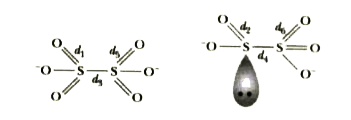Bent's rule explains the relative position of atoms and lone pairs in trigonal bipyramidal and pentagonal bipyramidal geometries mainly. However, the bond lengths and bond angles are also well explained in several places.
Which of the following statements is not correct?
In PF2Br3,dP−F>dP−Br.
All ˆFPBr angles are of 90∘ in PF2Br3.
All ˆBrPBr angles are of 120∘ in PF2Br3.
Fluorine atom occupies axial position.
The correct Answer is:A
Similar Questions
According to VSEPR model, molecules adopt geometries in which their valence electron pairs position themselves as far from each other as possible. The VSEPR model considers double and triple bonds to have slightly greater repulsive effects than single bonds because of the repulsive effect of π -electrons. However the lone pair creates the maximum repulsive effect.
Which of the following statement is false ?
View SolutionAccording VSEPR theory, in the electronic geometry of the molecule(s), electron pair tend to minimise repulsion and follow the repulsion order in presence of lone pair of electrons with bond pair of electrons. lp-lpgt lp-bp gtbp-bp
and similarly double bond pair of electrons follow the repulsion order with angle bond pair of electrons. double bond -double bond gt double bond -single bond gtsingle bond -single bond
Which of the following statement is CORRECT about XeO2F2
View Solution
Knowledge Check
Bent's rule explains the relative position of atoms and lone pairs in trigonal bipyramidal and pentagonal bipyramidal geometries mainly. However, the bond lengths and bond angles are also well explained in several places.
Which of the following species does not have perfect geometrical shape?A[BeF4]2−BCF3ClC[SiF6]2−DSO3Bent's rule explains the relative position of atoms and lone pairs in trigonal bipyramidal and pentagonal bipyramidal geometries mainly. However, the bond lengths and bond angles are also well explained in several places.
Which of the following options are correct statements?
(I) dO−F(O2F2)>dO−F(OF2)
(II) The %s character in the orbital containing lone pair of H2O molecule is 30% [where cos(104.5∘)=−0.25].
(III) ˆHCH angle in CH3−C≡CH is exactly equal to 109∘28'.
(IV) The ˆFNF in [NF3]− is less than ˆHNH in [NH2]−.AI, II, IIIBII, IVCI, II, IVDII, III, IVThe approximate shape of a molecule can often be predicted by using what is called the valence-shell electron-pair repulsion (VSEPR) model. Electrons in bonds and in lone pairs can be thought of a ''charge cloud'' that repel one another nad stay as far apart as possible, thus causing molecules to assume specific shapes.
The repulsive interactions of electron pairs decrease in the order:
Lone pair - Lone pair gt Lone pair - Bond pair gt Bond pair - Bond pair
These repulsive effects result in deviations from idealised shapes and alteration in bond angles in molecules.
Which of the following statement is correct with respect ot bond angles?AThe F−S−F angle in SF2 is more than 109∘28'BThe H−N−N angle in N2H2 is approximately 180∘CThe F−Kr−F angle in KrF4 is 90∘DThe Cl−N−O angle in NOCl is more than 120∘
The approximate shape of a molecule can often be predicted by using what is called the valence-shell electron-pair repulsion (VSEPR) model. Electrons in bonds and in lone pairs can be thought of a ''charge cloud'' that repel one another nad stay as far apart as possible, thus causing molecules to assume specific shapes.
The repulsive interactions of electron pairs decrease in the order:
Lone pair - Lone pair gt Lone pair - Bond pair gt Bond pair - Bond pair
These repulsive effects result in deviations from idealised shapes and alteration in bond angles in molecules.
Which of the following statements is incorrect?
View SolutionWhich of the molecules has trigonal bipyramidal geometry with bond angles 120∘ and 90∘?
View SolutionAccording to VSEPR model, molecules adopt geometries in which their valence electron pairs position themselves as far from each other as possible. The VSEPR model considers double and triple bonds to have slightly greater repulsive effects than single bonds because of the repulsive effect of π -electrons. However the lone pair creates the maximum repulsive effect.
Which of the following statement is false ?
View SolutionAccording to VSEPR model, molecules adopt geometries in which their valence electron pairs position themselves as far from each other as possible. The VSEPR model considers double and triple bonds to have slightly greater repulsive effects than single bonds because of the repulsive effect of π -electrons. However the lone pair creates the maximum repulsive effect.
Which of the following statement is false ?
View SolutionAccording to Bent's rule, more electronegative atom prefers to stay in that hybrid orbital which has less s-character and lone pair prefers to stay in that hybrid orbital which has more s-character.
Consider the molecules given below and answer the following question

Which of the following bond length order is correct?
View Solution
